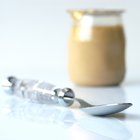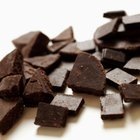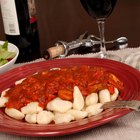
Cornstarch thickens dishes that are in appropriate for roux, or equal parts fat and flour, such as puddings and glazes. It also can be used to replace roux in others, such as soups and sauces. Cornstarch doesn't impart a flavor or aroma when it thickens, but it doesn't work alone; you have to mix it with cold water to form a slurry. You need a 1-to-1 ratio of cornstarch to water to thicken a sauce.
Mixing the Slurry
Whisk 1 tablespoon of cornstarch with 1 tablespoon of cold water for every cup of sauce you want to thicken a few minutes before you finish cooking it. Store the slurry in the refrigerator while you finish cooking the sauce.
Thickening the Sauce
Finish cooking the sauce and season it to taste. Lower the temperature of the stove until the sauce just stops simmering. Take the slurry out of the fridge and whisk it again to suspend the starch granules. Pour it into the sauce a little at a time, whisking constantly. After you add the slurry, cook the sauce for about 4 or 5 minutes so that the starch granules completely gelatinize.
Related Articles

Can Baking Powder Replace Corn Starch?

How to Substitute Potato Starch for ...

How to Thicken Sauce With Powdered ...

How to Make Liquid Sugar Concentrate

How to Make Simple Homemade Gravy

How Long Can You Refrigerate Nacho ...

How to Freeze Yogurt Sauce

How to Cook Chicken Breasts in Prepared ...

How to Make Creamy Alfredo Sauce With ...

Good Marinade for a Chicken & Steak ...

How to Get Half & Half to Thicken

How to Make Shrimp Cocktail

How to Freeze Marinara Sauces

How to Get a Marriage Certificate Online

How Can I Counteract the Sourness of a ...

How to Fix Too Much Italian Seasoning ...
Pot Sticker Dipping Sauce Recipe

Can You Refreeze Cooked Spaghetti Sauce ...

How to Make a Juicy Pork Tenderloin

How to Substitute Cornstarch for ...
References
Writer Bio
A.J. Andrews' work has appeared in Food and Wine, Fricote and "BBC Good Food." He lives in Europe where he bakes with wild yeast, milks goats for cheese and prepares for the Court of Master Sommeliers level II exam. Andrews received formal training at Le Cordon Bleu.
Photo Credits
Image Source/Photodisc/Getty Images